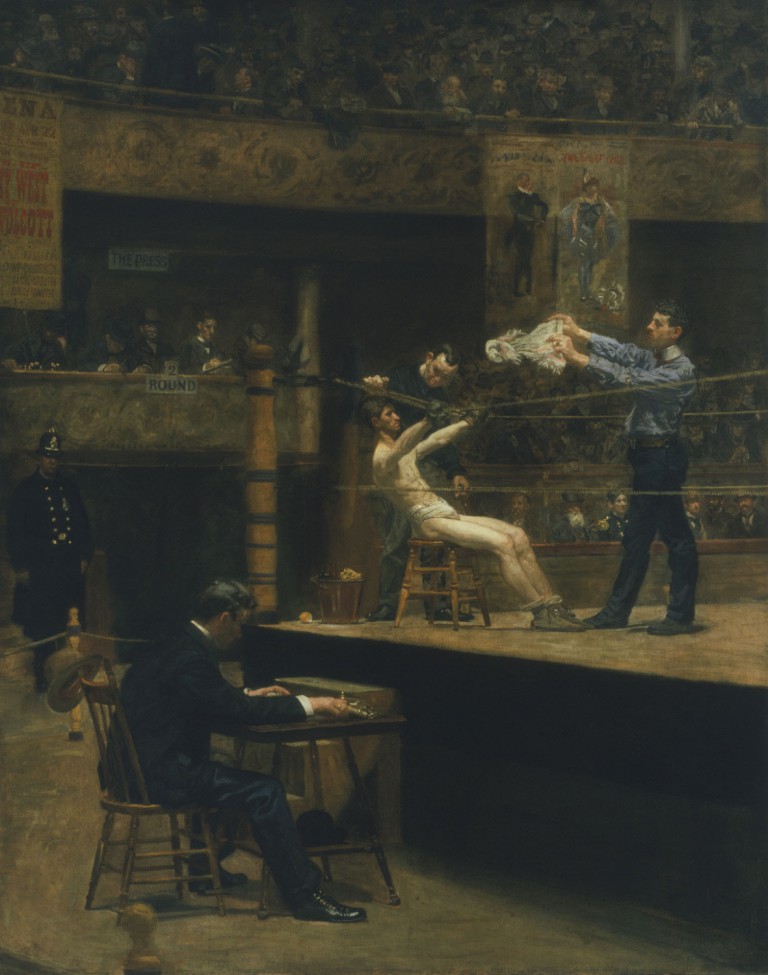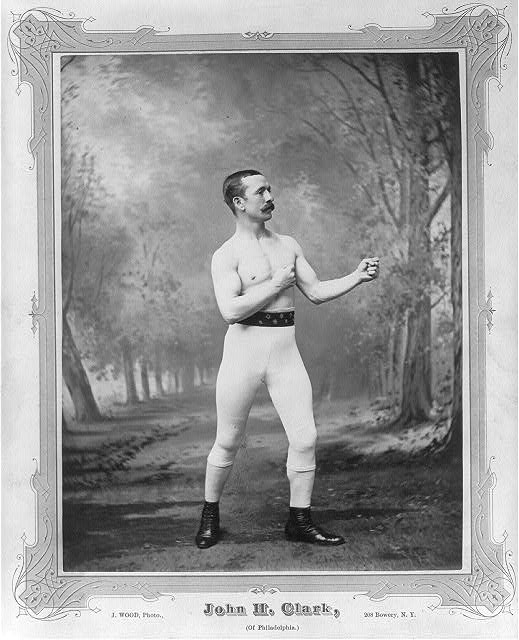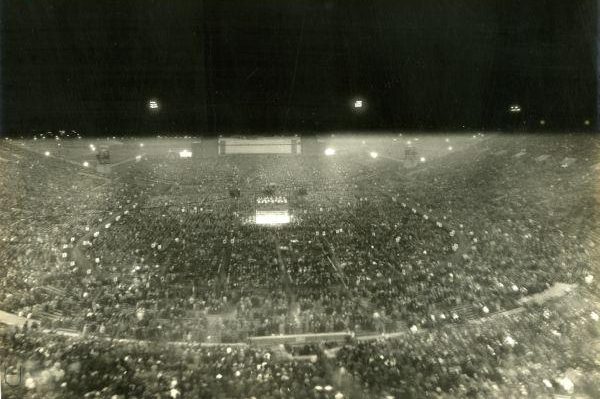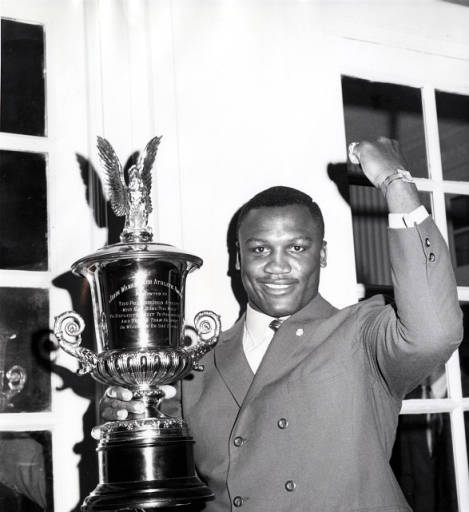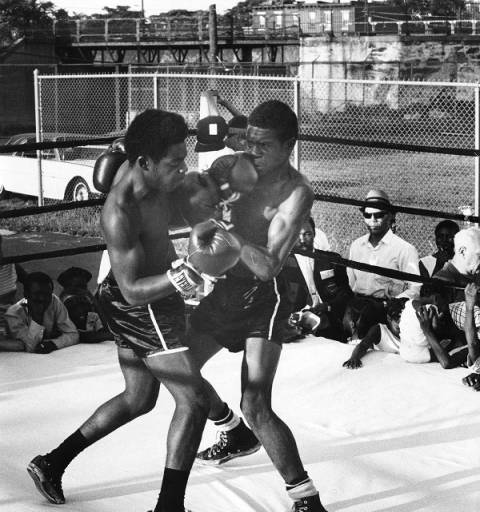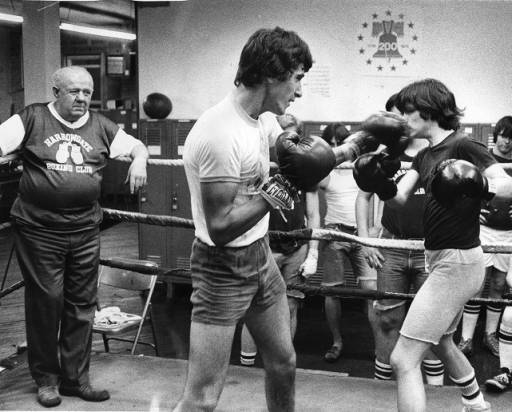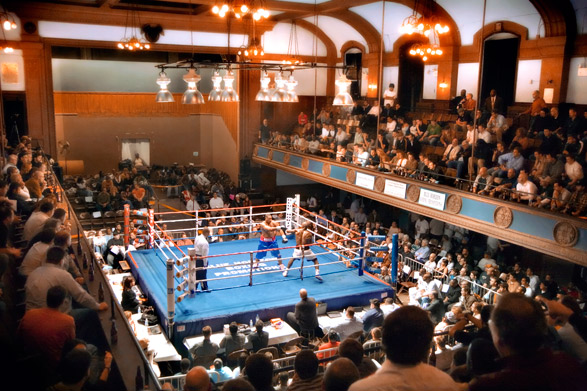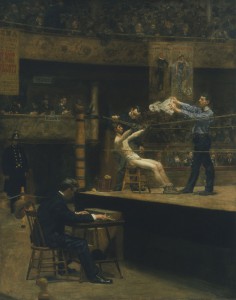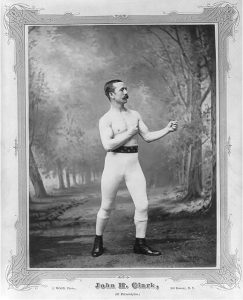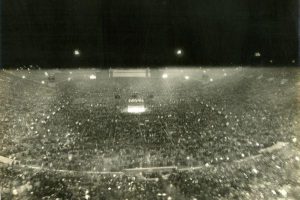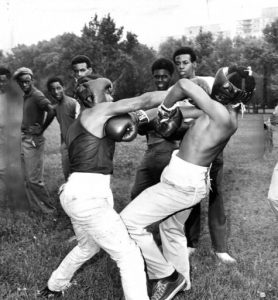Boxing and Boxers
By Matthew Ward
Essay
For over one hundred years, Philadelphia neighborhoods, for better and worse, played a significant role in molding fighters. Over two dozen world boxing champions throughout various weight classes called Philadelphia home. Nearby communities such as Camden, New Jersey, and Easton, Pennsylvania, also produced world champions. Over time, Philadelphia-area boxing was supported by a wide network of more than fifty gyms into the twenty-first century. Thousands of young people who sought a better life trained in those gyms, where, frequently, they found escape from the hazards of gang violence, local rivalries, criminal activity, and drugs.
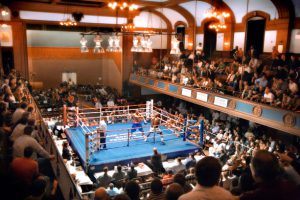
The greater Philadelphia area embraced the sport of boxing as far back as the days of bare-knuckle boxing, with great fighters becoming champions of their neighborhoods. In 1876, two Philadelphia bare-knuckle fighters, “Philadelphia” Jimmy Weeden (1846-77) and Billy Walker (1857-76), fought before a crowd of gamblers on a barge near Pennsville, New Jersey. Walker lost the fight and died from injuries sustained in the contest. Weeden was arrested for his participation in the bout and died one year later in a Trenton prison. Public and legal outrage from this bout resulted in the establishment of the Philadelphia Rules for boxing. This regulation, created by Philadelphia City Councils in cooperation with the county sheriff’s office, included new rules on the location and duration of fights in the city. Boxing matches were required to take place within the city limits and contests could last no longer than four rounds, a restriction that was later changed to six rounds for scoring purposes.
Weeden and Walker were only two of the bare-knuckle boxers from Philadelphia who had lasting impacts on the sport. John Clark (1849-1922) and Arthur Chambers (1846-1923), both of whom immigrated to the United States from the British Isles, opened boxing schools (early boxing gyms) in the late nineteenth century and developed local talent in Philadelphia. As the twentieth century approached, Philadelphia began to emerge as a leading world fight center. Throughout the early 1900s, the sport of boxing was especially popular with poor immigrant groups from Europe. Members of the city’s African American population, which jumped from 34,000 to 480,000 between 1850 and 1950, also played important roles in developing the sport and its popularity. In the later decades of the twentieth century, the sport of boxing became a fixture in the city’s Hispanic communities, which more than doubled between 1990 and 2010.
Boxing Hall of Famers Jack Dempsey (1895-1983) and Gene Tunney (1897-1978) fought the first of their two world heavyweight title bouts at Sesquicentennial Stadium in South Philadelphia on September 23, 1926. Tunney defeated the Manassa Mauler in ten rounds via unanimous decision in front of a crowd of over 120,000 fans in one of the best-known fights of the 1920s, a decade when boxing was considered the king of sports. The Philadelphia Chamber of Commerce estimated that spectators brought in an additional $3 million in revenue to the city around the time of this bout.
1940s: Eight Championship Matches
Philadelphia hosted eight championship boxing matches in the 1940s, more than in any other decade in city history. Leading up to this decade, black fighters with few exceptions were typically denied entry into mainstream bouts. Those who were able to fight on boxing’s main stage were often confronted with racism and had little control over their careers. Despite being confronted with social and racial obstacles, black boxers performed with distinction during the period. Black lightweight champions Ike Williams (1923-94) of Trenton and Bob Montgomery (1919-98) of Philadelphia both fought several times. On December 5, 1947, Homesteadville, New Jersey, native Arnold Cream (1914-1994), better known as Jersey Joe Walcott, squared off against heavyweight champion Joe Louis (1914-81) at Madison Square Garden. The final decision from the judges was two-to-one in favor of Louis over underdog Walcott, a result considered by many historians to be one of the most controversial decisions in boxing history.
Although Walcott lost to Louis in a controversial decision, his participation in this bout proved to have a deeper impact on race, sports, and society as the first time a black boxer broke the color line. Prior to this bout, boxing promoters and writers were at times skeptical of the willingness of white fans to pay to see a black man fight. Ticket sales at the Louis-Walcott fight proved that white boxing fans were willing to attend a bout featuring a black champion defend his title against a black challenger. Ticket sales of $216,477 broke a record that had stood for twenty years at the Garden. Furthermore, when Walcott returned to Camden he was given a hero’s welcome by a crowd of over 100,000 South Jersey fans, of all social classes and ethnicities. Camden Mayor George Brunner (1896-1975) called Walcott’s welcome home gathering the “greatest single event in Camden’s history.”
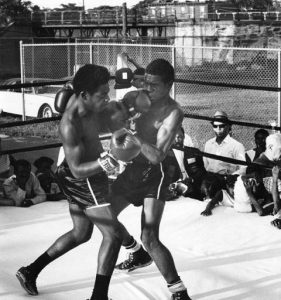
Also in 1947, members of the Philadelphia Police Department founded the nonprofit Police Athletic League (PAL) to provide North Philadelphia’s youth with after-school sports, a refuge to escape the dangers of the streets, and educational and cultural programs. The Twenty-Third District PAL boxing program, located in a traditionally high crime area of North Philadelphia, served as the training grounds for numerous professional boxers including Joe Frazier (1944-2011) and Bennie Briscoe (1943-2010).
In Philadelphia, rivalries from the streets often came into the gyms. Neighborhood rivalries could become violent sparring sessions known as “gym wars.” Considered by many fighters to be far rougher than the bouts they were training for, these sparring sessions caused some champion fighters and their trainers to refuse to train for bouts in the area.
The Hollywood film Rocky, released in 1976, captured the sense of pride and the power to overcome adversity that emanated from those hardscrabble neighborhoods, many of which were burdened by high levels of poverty and crime. The fictional character Rocky Balboa was a tough fighter from an Italian immigrant family who rose from the streets of Philadelphia to capture the World Light Heavyweight championship. Fighters from the Greater Philadelphia region often came from poor or working-class neighborhoods.
Joe Frazier’s Gym
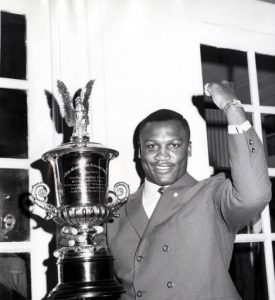
Joe Frazier provided a real-life parallel to the Rocky story. In 1975 he purchased the gym on North Broad Street that he had used since the 1960s from an investment group and reopened it to the public as Joe Frazier’s Gym, where he trained future generations of Philadelphia fighters. Frazier’s facility served as a safe haven from the dangers and distractions of the streets for the city’s inner-city youth. Frazier dominated the Philadelphia boxing scene throughout the 1970s, holding the World Heavyweight Title from 1970-73. He became best remembered for his trilogy of fights against Muhammad Ali in 1971, 1974, and 1975, including his victory over Ali (1942-2016) in 1971 at Madison Square Garden.
In 1961, the legendary Blue Horizon opened its doors to professional boxing shows on North Broad Street in North Philadelphia. For most Philadelphia boxing fans who packed the hall, the former Moose Hall was Mecca. Fight fans sitting in the balcony of the Blue Horizon were right on top of the action.
In 1976, after gambling was legalized in Atlantic City, casinos became prime boxing locations, often at Philadelphia’s expense. The city’s Boardwalk Hall had been available for sports events from the time it opened in 1929, but the presence of the casinos attracted numerous title fights to the oceanfront city from the 1980s to the 2000s. Among them were Undisputed Heavyweight Champion title defenses in Boardwalk Hall by Mike Tyson (b. 1966) and Evander Holyfield (b. 1962).
In Philadelphia, locations such as Joe Hand Gym in Northern Liberties continued to play an important role in the community in the 1990s. Founded in 1995 by promoter Joe Hand Sr. (b. 1936), this gym provided local children and teens with a place to not only train in boxing, but also to train in academics. The gym provided members with access to a computer lab and stressed the importance of brains and brawn.
Boxing Persists in Philadelphia
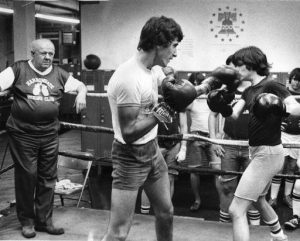
Although once one of the most popular sports in the United States, along with baseball and horse-racing, boxing by the twenty-first century had been surpassed by other sports including football, basketball, ice hockey, and auto racing. Even as interest in boxing declined nationally, however, it maintained a hold in the Philadelphia area. Twenty-eight-year-old Juniata Park native Danny Garcia (b. 1988) captured his first world championship in 2012 in Houston and was celebrated as the city’s first Hispanic world champion. When Garcia was just ten years old, his ex-convict father, Angel, introduced him to Juniata Park’s Harrowgate Boxing Club, a reservoir of boxing tradition for the largely Puerto Rican neighborhood. Green shamrocks over the gym’s entrance served as a reminder of working-class, Irish-American fighters who called the neighborhood home before the late 1980s. In the Philadelphia fashion, Garcia opened a gym in his neighborhood in 2013 to give back to his community and mentor fighters in the neighborhood’s Puerto Rican population.
Philadelphia rarely attracted major fights in the twenty-first century due to the continued popularity and lure of nearby Atlantic City, Las Vegas, and numerous Native American-run casinos around the country. In April 2008, the legendary gym and staple of North Philadelphia, Joe Frazier’s Gym, closed due to Frazier’s health issues, unmanageable debt, and back taxes. Philadelphia’s popular boxing venue the Blue Horizon closed in 2010 because of the deterioration of the building, tax issues, and the decline of the surrounding neighborhood. The loss of the Blue Horizon also caused numerous local boxing promoters to move their cards to Atlantic City venues.
Still, other Philadelphia boxing landmarks survived the challenges of the twenty-first-century. Since the 1950s, boxers, including numerous world champions, trained in Front Street Gym on the border between largely white, working-class Port Richmond and primarily Hispanic Kensington. The gym was featured in the sixth installment of the Rocky series, Creed (2015), which co-starred Gabriel Rosado (b. 1986), a popular fighter of Puerto Rican descent from North Philadelphia. Owner Frank Kubach and his staff spent over twenty-five years motivating youth from the surrounding areas to not only be better boxers, but also better citizens. He refused to collect dues from members under the age of eighteen to ensure that they had a place to train. The gym’s role in the community and its presence in the film instilled a renewed sense pride in the neighborhood for area residents and continued Philadelphia’s boxing tradition.
Matthew Ward is a graduate student in History at Rutgers University—Camden. He graduated from Arizona State University in 2007, with a B.A. in History and Culture. He has worked in financial services for over seven years and serves as a commissioned officer in the U.S. Army Reserve. He is also an Army veteran who served in support of Operation Iraqi Freedom from 2010 to 2011. He grew up on the Jersey Shore and resides in King of Prussia, Pennsylvania. He runs a blog and monthly podcast called The Matt Ward History Experience. (Author information current at time of publication.)
Greater Philadelphia Area’s Boxing Champions
Danny Dougherty (1876-1931), Philadelphia: World Bantamweight Champion.
Philadelphia Jack O’Brien (1878-1942), Philadelphia: Light Heavyweight Champion.
Harry Lewis (1886-1956), Philadelphia: World Welterweight Champion.
Battling Levinsky (1891-1949), Philadelphia: Light Heavyweight Champion.
Benny Bass (1903-75), Philadelphia: World Featherweight and World Junior Lightweight Champion.
Tommy Loughran (1902-82), Philadelphia: World Light Heavyweight Champion.
Midget Wolgast (1910-55), Philadelphia: New York World Flyweight Champion.
Johnny Jadick (1908-70), Philadelphia: World Junior Welterweight Champion.
Ike Williams (1923-94), Trenton: NBA World Lightweight Champion.
Bob Montgomery (1919-98), Philadelphia: New York World Lightweight Champion.
Jersey Joe Walcott (1914-94), Camden: National Boxing Association (NBA) World Heavyweight Champion.
Percy Bassett (1930-93), Philadelphia: Interim World Featherweight Champion.
Harold Johnson (1928-2015), Philadelphia. NBA World Light Heavyweight and World Light Heavyweight Champion.
Sonny Liston (1932-70), Philadelphia. World Heavyweight Champion.
Joey Giardello (1930-2008), Philadelphia: World Middleweight Champion.
Joe Frazier (1944-2011), Philadelphia: New York World Heavyweight and World Heavyweight Champion.
Bennie Briscoe (1943-2010), Philadelphia: North American Boxing Federation (NABF) Middleweight Champion.
Larry Holmes (b. 1949), Easton: World Boxing Council (WBC) World Heavyweight and IBF World Heavyweight Champion.
Mike Rossman (b. 1955), Philadelphia: WBA World Light Heavyweight Champion.
Matthew Saad Muhammad (1954-2014), Philadelphia: WBC World Light Heavyweight Champion.
Jeff Chandler (b. 1956), Philadelphia: World Boxing Association (WBA) World Bantamweight Champion.
Dwight Muhammad Qawi (b. 1953), Camden: WBC World Light Heavyweight, WBA World Cruiserweight, WBC Continental Americas Cruiserweight Champion.
Charlie “Choo-Choo” Brown (b. 1958), Philadelphia: IBF World Lightweight Champion.
David Bey (b. 1957), Philadelphia: United States Boxing Association (USBA) Heavyweight Champion.
Tim Witherspoon (b. 1957), Philadelphia: WBA World Heavyweight Champion.
Calvin Grove (b. 1962), Coatesville: USBA Featherweight and IBF World Featherweight Champion.
Tyrone Crawley (b. 1958), Philadelphia: NABF Lightweight Champion.
Gary Hinton (b. 1956), Philadelphia: USBA Super Lightweight, WBC Continental Americas Super Lightweight, IBF World Junior Welterweight Champion.
Buster Drayton (b. 1954), Philadelphia: International Boxing Federation (IBF) World Junior Middleweight Champion.
Robert Hines (b. 1961), Philadelphia: USBA Super Welterweight and IBF World Junior Middleweight Champion.
Bert Cooper (b. 1966), Sharon Hill: NABF Cruiserweight and World Boxing Federation World Heavyweight Champion.
Fred Pendleton (b. 1963), Philadelphia: USBA Lightweight and IBF World Lightweight Champion.
Meldrick Taylor (b. 1966), Philadelphia: IBF World Junior Welterweight and WBA World Welterweight Champion.
Nate Miller (b. 1963), Philadelphia: NABF Cruiserweight and WBA World Cruiserweight Champion.
Ivan Robinson (b. 1971), Philadelphia: USBA Lightweight and NABF Lightweight Champion.
Bernard Hopkins (b. 1965), Philadelphia: IBF World Middleweight, WBC World Middleweight, Linear World Light Heavyweight, WBC Light Heavyweight, IBF Light Heavyweight, and WBA Light Heavyweight Champion.
Bruce Seldon (b. 1967), Atlantic City: IBF Inter-Continental Heavyweight and WBA World Heavyweight Champion.
Leavander Johnson (1969-2005), Atlantic City: NABF Lightweight, USBA Lightweight, and IBF World Lightweight Champion.
Charles Brewer (b. 1969), Philadelphia: IBF World Super Middleweight Champion.
David Reid (b. 1973), Philadelphia: WBA World Junior Middleweight Champion.
Jackie Frazier-Lyde (b. 1961), Philadelphia: WIBA World Light Heavyweight and WIBF World Super Middleweight Champion.
Zahir Raheem (b. 1976), Philadelphia: WBA-NABA Featherweight, WBC International Lightweight, and WBO-NABO Super Lightweight Champion.
Terrance Cauthen (b. 1976), Trenton: NABF Super Lightweight, WBA-NABA Super Lightweight, IBU World Super Welterweight, USBA Super Welterweight Champion.
Yusaf Mack (b. 1980), Philadelphia: USBA Super Middleweight, WBA-NABA Light Heavyweight, NABF Light Heavyweight, and USBA Light Heavyweight Champion.
Demetrius Hopkins (b. 1980), Philadelphia: USBA Super Lightweight and USBA Super Welterweight Champion.
Lajuan Simon (b. 1979), Philadelphia: USBA Middleweight Champion.
Steve Cunningham (b. 1976), Philadelphia: IBF Cruiserweight Champion.
Mike Jones (b. 1983), Philadelphia: North American Boxing Association (NABA) Welterweight Champion and WBO-NABO Welterweight Champion.
Danny Garcia (b. 1988), Philadelphia: WBC Junior Welterweight, WBA and Ring Junior Welterweight, and WBC Welterweight Champion.
Teon Kennedy (b. 1986), Philadelphia: USBA Super Bantamweight and WBA-NABA Super Bantamweight Champion.
Hank Lundy (b. 1984), Philadelphia: WBO-NABO Lightweight, NABF Lightweight, and WBC Continental Americas Lightweight Champion.
Gabriel Rosado (b. 1986), Philadelphia: WBA-NABA Super Welterweight and WBO Inter-Continental Super Welterweight Champion.
Karl Dargan (b. 1985), Philadelphia: NABF Junior Lightweight Champion.
Julian Williams (b. 1990), Philadelphia, WBC Continental Americas Super Welterweight Champion.
Jason Sosa (b. 1988 ), Camden, WBA World Super Featherweight Champion.
Notable Bouts in the Greater Philadelphia Area
Jack Johnson (W) vs. Joe Butler (May 11, 1903), Washington Sports Club, Philadelphia.
Mickey Walker (W) vs. Lew Tendler for the National Boxing Association World Welterweight Title (June 2, 1924), Shibe Park, Philadelphia.
Jack Dempsey vs. Gene Tunney (W) for the National Boxing Association World Heavyweight Title (September 23, 1926), Sesquicentennial Stadium, Philadelphia.
Joe Louis (W) vs. Gus Dorazio for the World Heavyweight Title (February 17, 1941), Convention Hall, Philadelphia.
Ike Williams (W) vs. Beau Jack for the World Lightweight Title (July 12, 1948), Shibe Park, Philadelphia.
Sugar Ray Robinson (W) vs. Kid Gavilan for the World Welterweight Title (July 11, 1949), Municipal Stadium, Philadelphia.
Kid Gavilan (W) vs. Gil Turner for the World Welterweight Title (July 7, 1952), Municipal Stadium, Philadelphia.
Jersey Joe Walcott (W) vs. Rocky Marciano for the World Heavyweight Title (September 23, 1952), Municipal Stadium, Philadelphia.
Joey Giardello (W) vs. Rubin Carter for the WBC World Middleweight and WBA World Middleweight Titles (December 14, 1964), Convention Hall, Philadelphia.
Joe Frazier (W) vs. Oscar Bonavena for the New York World Heavyweight Title (December 10, 1968), Spectrum, Philadelphia.
Dwight Muhammad Qawi (W) vs. Matthew Saad Muhammad WBC World Light Heavyweight Title (December 19, 1981), Playboy Hotel and Casino, Atlantic City.
Dwight Muhammad Qawi (W) vs. Matthew Saad Muhammad for the WBC World Light Heavyweight Title (August 7, 1982), Spectrum, Philadelphia.
Mike Tyson (W) vs. Tyrell Biggs for the WBC World Heavyweight, WBA World Heavyweight, and the IBF World Heavyweight Titles (October 16, 1987), Convention Hall, Atlantic City.
Mike Tyson (W) vs. Larry Holmes for the WBC World Heavyweight, WBA World Heavyweight, and the IBF World Heavyweight Titles (January 22, 1988), Convention Hall, Atlantic City.
Aaron Davis vs. Meldrick Taylor (W) for the WBA World Welterweight Title (January 19, 1991), Convention Center, Atlantic City.
Evander Holyfield (W) vs. George Foreman for the WBC World Heavyweight, WBA World Heavyweight, and the IBF World Heavyweight Titles (April 19, 1991), Convention Hall, Atlantic City.
Bernard Hopkins (W) vs. Wayne Powell for the vacant USBA Middleweight Title (December 4, 1992), Merv Griffin’s Resorts, Atlantic City.
Arturo Gatti (W) vs. Mickey Ward – 2003 Ring Magazine Fight of the Year (June 7, 2003), Boardwalk Hall, Atlantic City.
Jermain Taylor vs. Kelly Pavlik (W) for the WBC World Middleweight and WBO World Middleweight Titles (September 29, 2007), Boardwalk Hall, Atlantic City.
Bernard Hopkins (W) vs. Karo Murat for the IBF World Light Heavyweight Title (October 26, 2013), Boardwalk Hall, Atlantic City.
Copyright 2016, Rutgers University
Gallery
Backgrounders
Connecting Headlines with History
- Happy Hollow boxing, four decades in the ring (WHYY, July 12, 2011)
- Philadelphia student to become youngest female boxing promoter (WHYY, September 29, 2011)
- Boxing fans pay tribute to Joe Frazier at Philadelphia arena (WHYY, November 11, 2011)
- Whose statue should be next? (WHYY, September 12, 2012)
- Philadelphia boxer Bernard Hopkins receives Wanamaker Athletic Award (WHYY, June 20, 2013)
- Chester boxing gym teaches youth, 'Put the guns down, pick the gloves up' (WHYY, August 21, 2013)
- Philly boxing gym recruits boys away from gang life (WHYY, November 6, 2013)
- Plan for Smokin' Joe Frazier statue wins approval (WHYY, December 4, 2013)
- Keeping Philly boys out of gangs with boxing gloves and early intervention (WHYY, November 6, 2013)
- Philly boxing champs hand out turkeys for Thanksgiving holiday (WHYY, November 26, 2013)
- Philly-born boxer Danny Garcia discusses upcoming title fight in Puerto Rico (WHYY, February 27, 2014)
- City Council honors boxer and advocate for deaf with Germantown roots (WHYY, October 23, 2014)
- Philadelphia (finally) honors legendary non-fictional boxer Smokin' Joe Frazier with a statue (WHYY, September 13, 2015)
- Countdown to auction of Philly's Blue Horizon boxing ring, memorabilia (WHYY, April 4, 2016)
- Thinking inside the boxing ring as therapy for Parkinson's (WHYY, July 13, 2016)
Links
- Tommy Loughran (1902-1982) Historical Marker (ExplorePAHisotry)
- The Legendary Blue Horizon Historical Marker (Explore PA History)
- Philly Boxing History (PhillyBoxingHistory.com)
- Joe Hand Boxing Gym
- Police Athletic League of Philadelphia (PAL)
- New Jersey Boxing Hall of Fame
- New Book Puts Readers In The Ring With Philly’s Jewish Boxing Stars (HiddenCity Philadelphia)
- Interior Designation For Blue Horizon’s Historic Boxing Arena Denied (HiddenCity Philadelphia)
- In Port Richmond, Boxing Lives On (HiddenCity Philadelphia)
